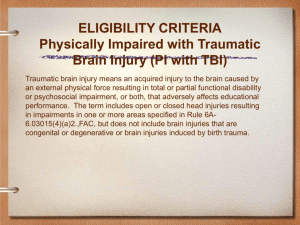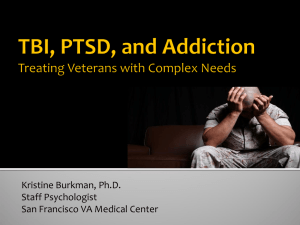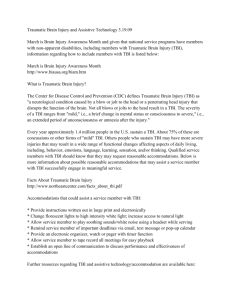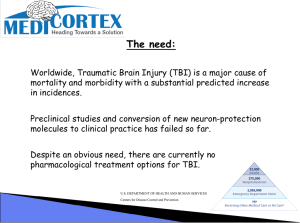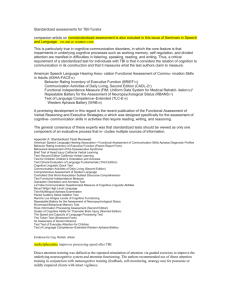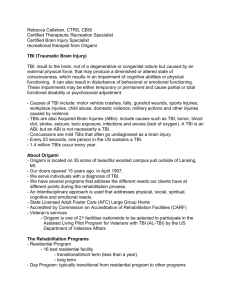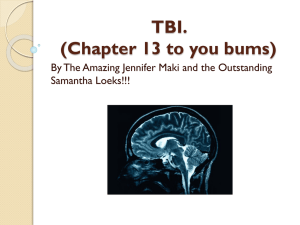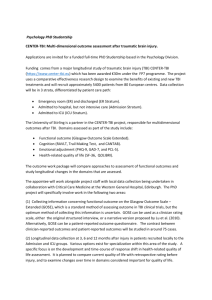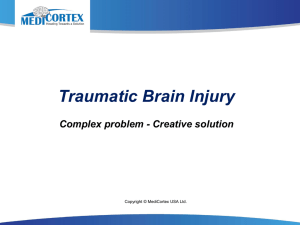(ST) after a Brain Injury - Brain Injury Alliance of Colorado
advertisement
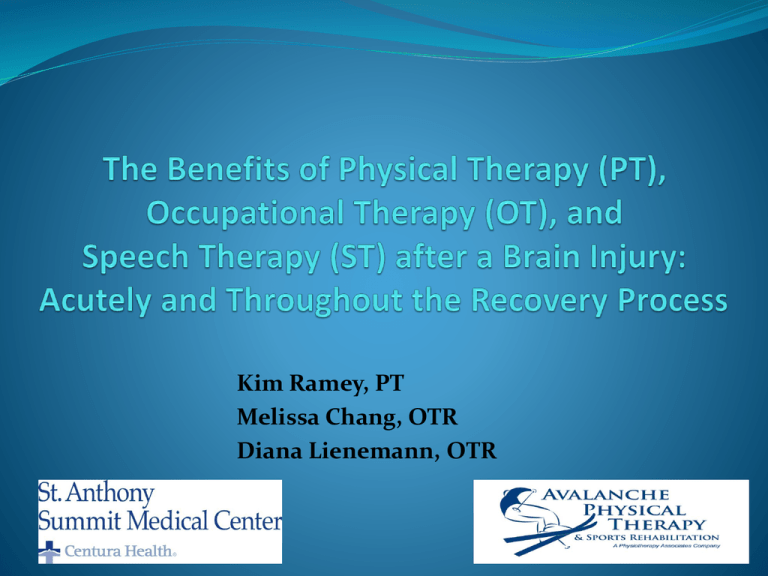
Kim Ramey, PT Melissa Chang, OTR Diana Lienemann, OTR Care is Not as EASY as You Think Kim Ramey, PT • TBI in the United States • Traumatic brain injury (TBI) is a serious public health problem in the United States. • Every year, at least 1.7 million TBIs occur either as an isolated injury or along with other injuries. • TBI is a contributing factor to a 30.5% of all injury-related deaths in the United States. • About 75% of TBIs that occur each year are concussions or other forms of mild TBI. • Children aged 0 to 4 years • Older adolescents aged 15 to 19 years • Adults aged 65 years and older are most likely to sustain a TBI • Adults aged 75 years and older have the highest rates of TBI-related hospitalization and death • Almost half a million (473,947) Emergency Department visits for TBI are made annually by children aged 0 to 14 years • Head injury is the #1 Trauma diagnosis in the SASMC ED • St. Anthony Summit Medical Center and Summit County clinics (BMC, CMC, KMC) see 2000 TBI patients per year • Summit County has 17 times more TBIs than the national statistic per capita • St. Anthony Summit Medical Center • ED • Inpatient Care • Mountain Clinics • Reduce • Educate • Accommodate • Pace Acute Care Treatment Guidelines: The REAP project Symptoms Headache Nausea Vomiting Balance Problems Dizziness Fatigue Trouble falling asleep Sleeping more than usual Sleeping less than usual Drowsiness Sensitivity to Light Sensitivity to Noise Irritability Sadness Nervousness / Anxiety Feeling more Emotional Numbness or Tingling Feeling Slowed Down Feeling “In a Fog” Difficulty Concentrating Difficulty Remembering Visual Problems Other Problems TOTAL Day Day #1 #2 Day Day Day Day Day Day Day Day Day # Day # Day Day #3 #4 #5 #6 #7 #8 #9 #10 11 12 #13 #14 Symptom Scoring • Evaluation • • • • • • • • History of Concussions/TBI’s MOCA – Montreal Cognitive Assessment GOAT – Galveston Orientation and AmnesiaTest Signs and Symptoms Balance Coordination Safety Mobility • Treatment • • • • • • • Patient/Family/Caregiver Education REST Settling Techiques Limit Sound and Light Limit Visitors and Hospital Staff Interuptions Mobility & ADL Training- Train/Educate on Safety Needs Continue Evaluation and Reassesment • • Signs and Symptoms Repeat the MOCA – if score below a 25 • Education • REST • Discharge Packet • • • REAP Symptom Scoring Tool Letters – English/Spanish • • • To Patient, Parents and/or Caregivers Supervisor, Principal, and/or School Team Coach Resource List • Follow up – 5-7 Days with a Physician • Accommodation • Screening for further evaluation • Resource List • No TBI diagnosis • Recent TBI diagnosis Melissa Chang, OTR, OTD • No TBI diagnosis • Lack of financial, transportation, and social resources • Instructed that symptoms will go away on their own • Not knowing how therapy can help • Objective Testing • Get a TBI diagnosis • Justify services • • • • • PT/OT/ST and other allied health interventions Insurance coverage Vocational rehab School Individualized Education Program (IEP) Social and financial support • • • • • Learn how to prevent a another head injury Develop insight and awareness Set realistic expectations for recovery Find hope Manage symptoms • Identify triggers • Learn sensory settling techniques • Balance rest with gradual exertion • Make accommodations with family, friends, school, and employers • Re-mediative and adaptive training • • Neuromuscular, vestibular-visual-somatosensory integration, cognition, balance, coordination, perceptual, communication, functional skills training Help determine readiness to return sport, school, work, and community participation Diana Horton Lienemann, OTR • The Senses • • • • • • • • • • • Vision/Sight Auditory/Sound Smell Taste Tactile Proprioception, Position, Movement Vestibular: Gravity, Head Movement, Balance Visceral Sensory Integration (SI) Sensory overload, fatigue, headaches Settling Techniques • Postural Control, Body Awareness • Normal Verses Abnormal Synergy Movement Patterns, Hemiparesis • Re-training • Compensatory • Patient and Family Education, • Family Involvement in Treatment • Community and Supportive Resources American Association of Neurological Suregons. (2001). Sports-Related Head Injury. http://www.aans.org/Patient%20Information/Conditions%20and%20Treatments/Sports-Related%20Head%20Injury.aspx Centers for Disease Control and Prevention - Injury Prevention & Control: Traumatic Brain Injury Giza, C., Kutcher, J., Ashwal, S. (2013). Summary of evidence-based guideline: Evaluation and management of concussion in sports: Report of the Guideline Development Subcommittee of the American Academy of Neurology. Harmon, K., Drezner, J., Gammons, M., Guskiewicz, K., Halstead, M., Herring, s., Kutcher, J., Pana, A., Putukian, M., & Roberts, W. (2013). American Medical Society for Sports Medicine Position Statement: Concussion in Sport. Clinical Journal of Sports Medicine, 23(1), 1-18. Kim, H, Colantonio A. (2010). Effectiveness of Rehabilitation in Enhancing Community Integration After Acute Traumatic Brain Injury: A Systematic Review. American Journal of Occupational Therapy, 64(5), 709-719. McAvoy, K. (2011). Rocky Mountain Youth Sports Medicine Institute. The REAP Project. Nalder E, Fleming J, Foster M, Cornwell P, Shields C, Khan A. (2012). Identifying Factors Associated With Perceived Success in the Transition From Hospital to Home After Brain Injury. Journal of Head Trauma Rehabilitation, 27(2), 143-153. Neuro Developmental Treatment (NDT) certification course material. Robbins J, Ayres AJ. (2005). Sensory Integration and the Child, Understanding Hidden Sensory Challenges. St. Anthony Summit Medical Center Trauma Database THANK YOU!
